*We recommend reading our article on how to choose the best flour for tempura first. All the information mentioned in this article is incorporated into our ultimately tempura batter technique. Otherwise, have a look at our tempura series.
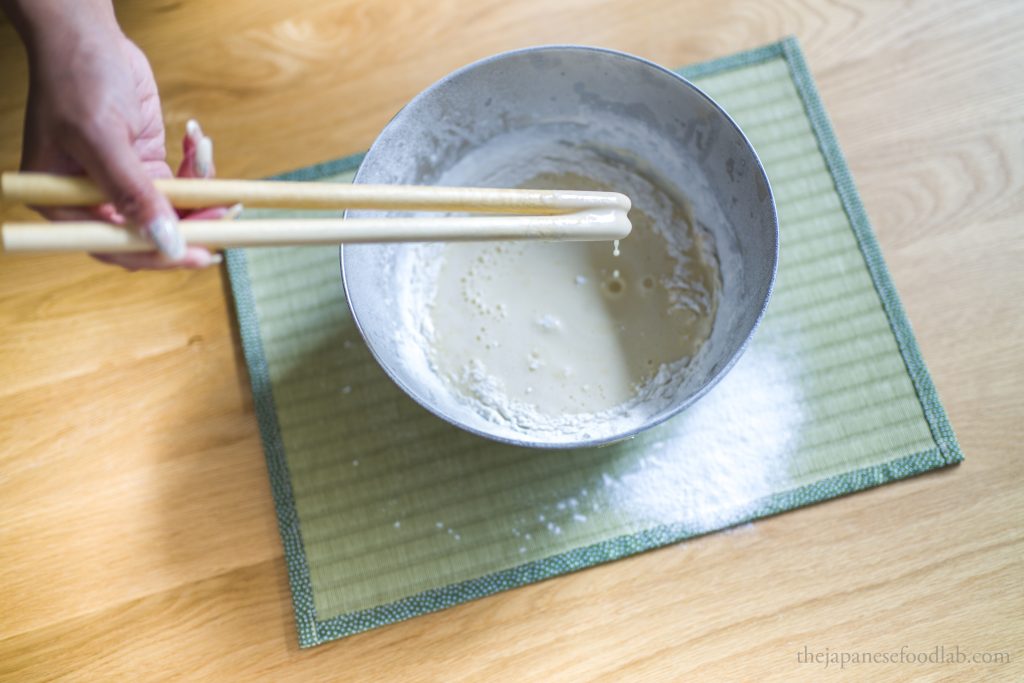
Mentioned in our primer on gluten, whilst the formation of your tempura batter’s gluten network will continue to occur spontaneously after the flour is hydrated, it will continue to do so slowly. However, this process can be sped up by mixing the batter. This can be seen in bread, where bread dough is typically mixed and kneaded to increase the rate of gluten development. Bread doughs mixed in machines can reach their required gluten development after 10-15 minutes of mechanical mixing, whilst the same amount of gluten development in a dough simply left to its own devices might require 12 to 24 hours of waiting.
Beyond developing a batter’s gluten network, the role of mixing also influences two important variables: how homogeneously combined the batter ingredients are, and how evenly the flour is hydrated. Whilst these two variables do have an effect on the quality of tempura produced, they have a much larger impact on maintaining the consistency between different batches of tempura batter.
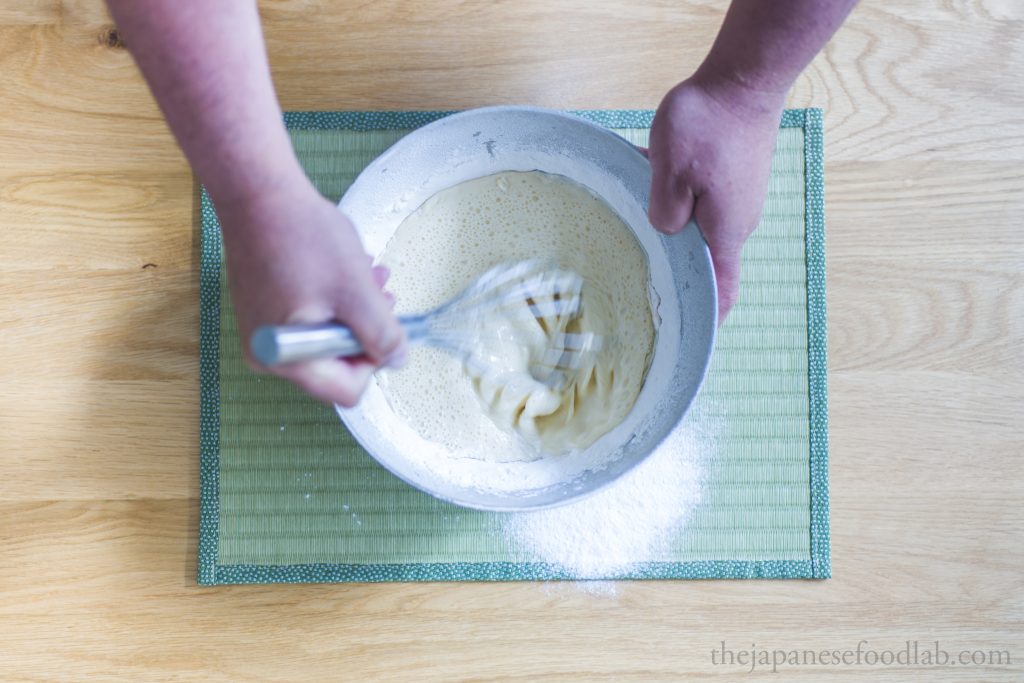
Traditional wisdom in making tempura batter
Unlike bread, a well-developed gluten network in tempura batter is unwanted as it yields tempura that is chewy and soggy. This is why traditional wisdom calls for tempura batter to be barely mixed with a pair of chopsticks. The batter should still have lumps of unmixed flour in it, and the water and eggs should not be fully combined. According to Shizou Tsuki in his legendary book Japanese Cooking Made Simple, the mark of a good tempura batter is that there still remains a powdery ring of flour at the sides of the mixing bowl with lumps of flour floating on top of the bowl. In fact he talks about this part so beautifully that I’m just going to quote him here:
The very act of dipping the materials in actually completes the mixing. The morsels pass through the batter ingredients roughly in an egg-water-flour sequence, since most of the flour is still floating on the water and the egg lies at the bottom of the bowl. This rudimentary combining procedure is what “does the trick.”
The idea back then was that barely mixing the tempura batter compounded with mixing using chopsticks, which are arguably a bad tool for mixing, would barely encourage any gluten development in the batter. As Japanese cooking became more and more prominent in the West, the above narrative about the practice that yields the best tempura batter has perpetrated food blogs and cookbooks all over the English speaking world and is even quoted by the most famous chefs.
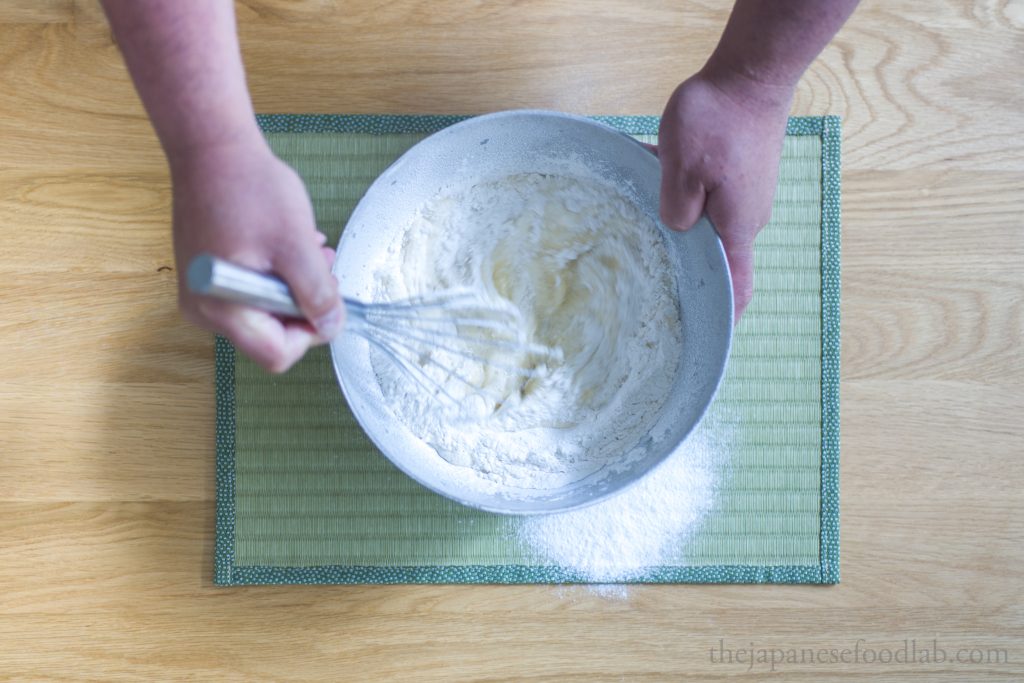
The secret behind traditional tempura batter
Whilst that seemed to be tempura’s happily ever after, inside Japan, a different story was unfolding. The pursuit to continuously refine and improve the techniques for making great tempura never stopped. As time went by, it became apparent that this method had its own flaws.
As mentioned throughout this series on tempura, the best tempura is one that is crispy on the first bite, before melting in your mouth. To achieve this texture, a kind of goldilocks zone of gluten development in the batter needs to be achieved. Too little gluten development and the resulting tempura batter shatters easily, giving it a sharp and crumbly texture. Too much gluten development and the tempura batter is chewy and soggy.
When barely mixing the tempura batter together with chopsticks, the initial tempura batter actually has insufficient gluten development, resulting in the first few pieces of tempura fried using this batter to have jagged and sharp edges as well as a brittle texture. As the meal continued, gluten development in the batter would continue to occur until the batter was just right, maybe after the first few pieces of tempura. At this point, it was possible to make beautiful pieces of tempura. However soon after, too much gluten development would occur and the batter was no longer usable.
This meant that tempura batter in restaurants sort of went through a bell shaped curve of tempura quality, starting at a low point, building up to a peak, before falling back down. Tempura chefs knew this at the time and tried to circumvent the problem using various techniques. For instance, they would make new batches of batter more frequently to replace batter past its prime, and would use ice to cool the batter and slow gluten formation, thus prolonging the lifespan of the batter. While all this alleviated the problems associated with the decline of batter quality with time, it never solved the problem associated with fresh tempura batter, which is that it took some time before the batter reached its peak quality.
Making tempura batter in this traditional method also meant that the degree to which the ingredients were combined together was largely dependent on how long the batter was mixed with chopsticks for. If one chef were to follow the same recipe with the same ingredient proportions but mixed for a longer period of time, this more fully combined the batter ingredients together as well as more evenly hydrates the flour, yielding a batter with a much higher level of gluten development. This not only resulted in a huge variability in tempura batter quality between different chefs using the exact same recipe, but huge variability within different batches of tempura batter made by the same chef. The only way to overcome this issue was to then spend many years in training as a tempura chef to develop the muscle memory and intuition to finally be able to make tempura batter that was consistently at a high quality for each and every batch.
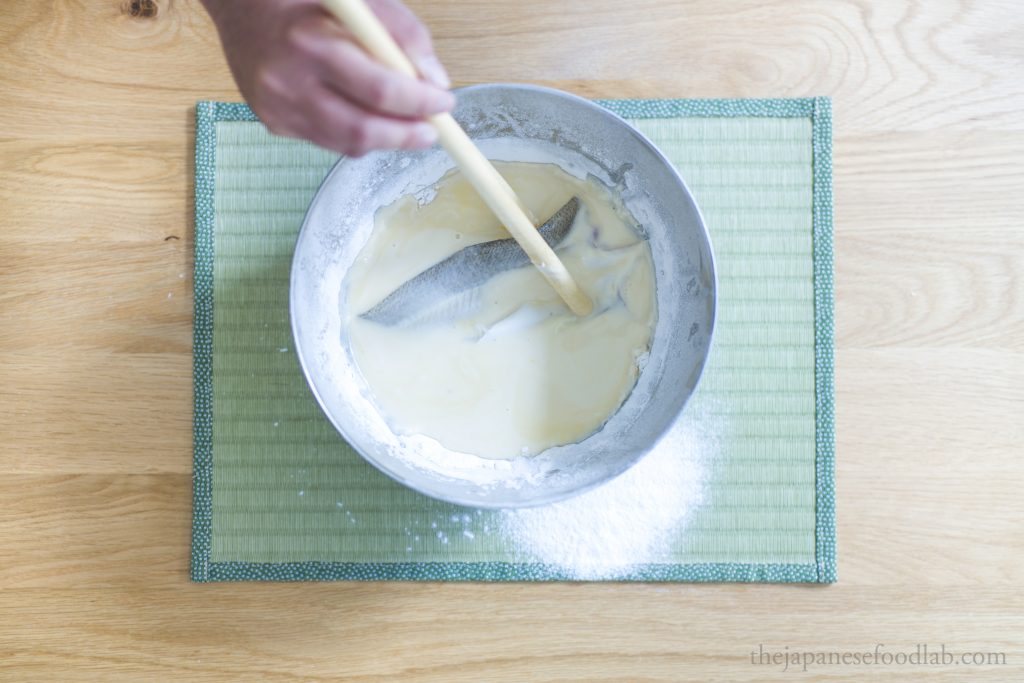
Modern day Japan’s leading tempura batter technique
Addressing this issue gave rise to a modern day tempura technique that has been adopted by many of the famous tempura establishments. Instead of lightly whisking the batter with chopsticks, tempura batter now tends to be whisked vigorously and quickly with a balloon whisk. Whilst counter-intuitive to the point of being sacrilegious at first sight, let’s shed some light onto this practice.
Instead of lightly whisking the tempura ingredients and then allowing time for gluten development to slowly build up over several minutes, this new technique simply calls for whisking the batter vigorously and stopping when the batter is at its peak quality. Here the amount of gluten development is in the goldilocks zone, where there is enough gluten to give the tempura a crispy and melt in your mouth texture, but not so much that the batter becomes chewy.
By making a batter that was in peak condition right from the very start, there was no lag time between the batter being made and perfect pieces of tempura being produced from the very first course. Of course this technique doesn’t solve the problem of the batter quality’s decline overtime, but then again this was still a problem with the old narrative around tempura making. To learn more about how to manage the decline in tempura batter quality, read our article on maintaining your tempura batter.
Using a whisk instead of chopsticks to mix the batter quickly was another innovative and crucial step to make this technique work. As a whisk is a much more efficient tool for mixing ingredients than chopsticks, one would assume it would be a poor tool for the purpose of making tempura batter as it would cause too much gluten development. Counterintuitively, the stroke of genius here is to use the whisk fast and vigorously. By doing so you can ensure that all the batter ingredients are homogeneously combined and the flour evenly hydrated in a short period of time, whilst simultaneously achieving the amount of gluten development in the batter you’d want. If you were to use chopsticks instead, by the time you were able to fully combine the tempura ingredients, the mixing action from the chopsticks would have over developed the gluten network in the tempura batter.
A good analogy for the explanation above is using a food processor to make shortbread or pie crust compared to using your bare hands. The speed of the spinning blades quickly combines the shortbread ingredients together, evenly distributing the butter into the flour in a matter of seconds. Because mixing is completed in such a short amount of time, there is very little gluten development that occurs, which is what keeps the shortbread cookies tender and crumbly instead of tough and chewy.
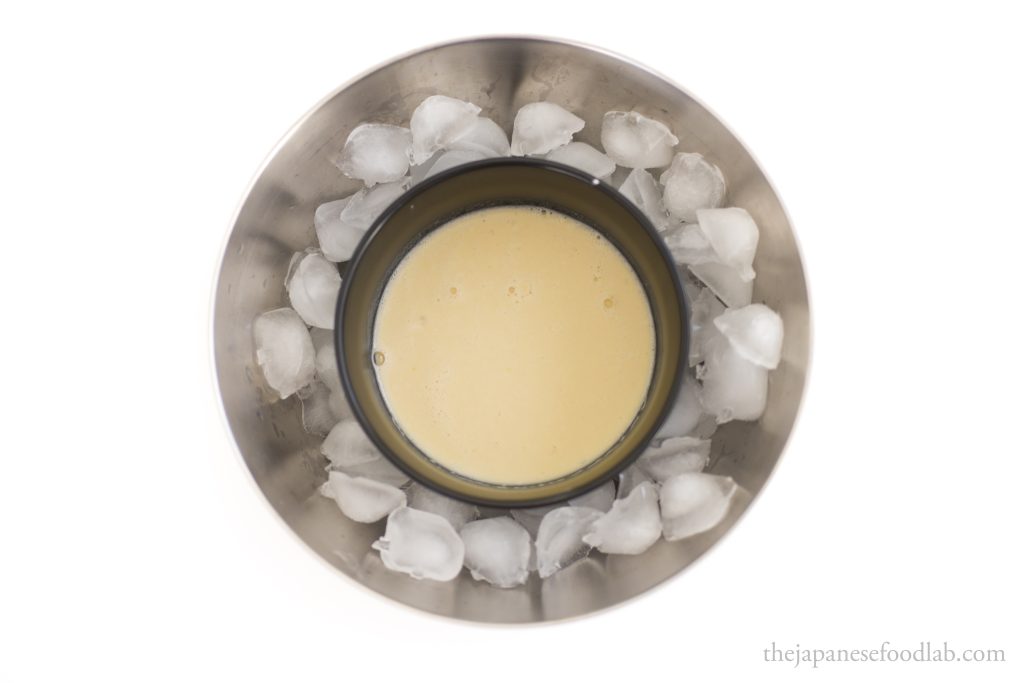
Why should we keep our tempura batter cold?
In our article on the science of koji, we elaborated on how temperature affects the rate of enzyme reactions. Whilst we talked specifically about the enzymes produced by koji, the explanations are still relevant here. This is because as mentioned in our primer on gluten, the formation of a gluten network in our tempura batter is due to two chemical processes running simultaneously together: the linking of glutenin and gliadin proteins, as well as the action of proteases naturally present in the flour.
As the rate of chemical reactions slows at lower temperatures, if we were to lower the temperature of the batter, it’s then possible to slow down the natural formation of gluten over time. This allows us to maintain our tempura batter at its peak state for a longer period of time, reducing the need to make new batches of tempura so frequently.
How do we keep our tempura batter cold?
Tempura batter at a specialty restaurant is typically kept cold using 3 basic techniques:
- Storing your tempura flour in the freezer (read tempura niitome’s recipe)
- Making your tempura batter with cold water
- Keeping your tempura batter bowl in the fridge prior to use.
Some chefs advocate the use of cold sparkling water when making tempura batter which is elaborated on in our article on tempura additives.
Making tempura batter as close to frying as possible
As our modern technique for making tempura batter requires us to whisk the batter until the optimal amount of gluten development is reached, the batter therefore starts to deteriorate from the moment of its creation. As such, it’s of utmost importance that you make your batter as close as possible to when you start frying. Experience chefs typically heat their oil to just the right temperature before quickly whisking together their batter. We recommend following the same advice where you have your ingredients prepared and oil heating up before you make your batter.
What to do after making our tempura batter?
Read more in our article on maintaining the lifespan of your tempura batter.